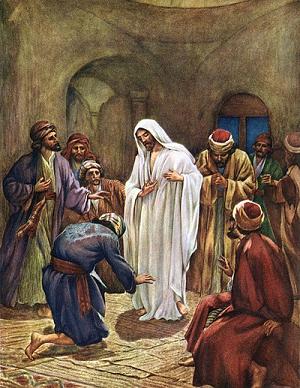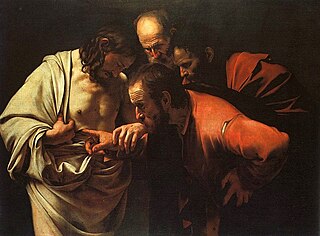
John 20:18 is the eighteenth verse of the twentieth chapter of the Gospel of John in the New Testament. It occurs after Jesus' resurrection and appearance to Mary Magdalene. In the previous verse Jesus has given Mary a message to deliver to his disciples, this verse describes how she delivers it.

John 20:19 is the nineteenth verse of the twentieth chapter of the Gospel of John in the New Testament. It describes what it says is the first appearance of Jesus to his disciples after Resurrection of Jesus, and in a locked room of a house.
Kyrios or kurios is a Greek word which is usually translated as "lord" or "master". It is used in the Septuagint translation of the Hebrew scriptures about 7000 times, in particular translating the name God YHVH, and it appears in the Koine Greek New Testament about 740 times, usually referring to Jesus.
The Koine Greek term Ego eimi, literally I am or It is I, is an emphatic form of the copulative verb εἰμι that is recorded in the Gospels to have been spoken by Jesus on several occasions to refer to himself not with the role of a verb but playing the role of a name, in the Gospel of John occurring seven times with specific titles. It is connected to the passage in Exodus 3:14 in which God gives his name as אֶהְיֶה אֲשֶׁר אֶהְיֶה, translated most basically as "I am that I am" or "I shall be what I am". In the Hebrew Bible, it is the personal name of God, revealed directly to Moses. These usages have been the subject of significant Christological analysis.
The New Testament was written in a form of Koine Greek, which was the common language of the Eastern Mediterranean from the conquests of Alexander the Great until the evolution of Byzantine Greek.

John 20:20 is the twentieth verse of the twentieth chapter of the Gospel of John in the New Testament. It contains the reaction the disciples to Jesus' first appearance after his resurrection and Jesus showing his hands and his side.

John 20:21 is the twenty-first verse of the twentieth chapter of the Gospel of John in the New Testament. It records Jesus' commission to the disciples during his first appearance after the resurrection.

John 20:22 is the twenty-second verse of the twentieth chapter of the Gospel of John in the New Testament. It records Jesus giving the Spirit to the disciples during his first appearance after the resurrection. Jesus gives Holy Spirit

John 20:23 is the twenty-third verse of the twentieth chapter of the Gospel of John in the New Testament. It records Jesus giving the power of forgiveness to the disciples during his first appearance after the resurrection.

John 20:24 is the twenty-fourth verse of the twentieth chapter of the Gospel of John in the New Testament. It contains the note that Thomas was absent when Jesus appeared for the first time to the disciples.

John 20:25 is the twenty-fifth verse of the twentieth chapter of the Gospel of John in the New Testament. It contains the reaction of Thomas after the other disciples told him about Jesus' appearance.

John 20:26 is the twenty-sixth verse of the twentieth chapter of the Gospel of John in the New Testament. It records Jesus' reappearance to the disciples, including Thomas, eight days after his resurrection.

John 20:27 is the twenty-seventh verse of the twentieth chapter of the Gospel of John in the New Testament. It records Jesus' reappearance to the disciples, including Thomas, eight days after his resurrection.

John 20:29 is the twenty-ninth verse of the twentieth chapter of the Gospel of John in the New Testament. It records Jesus' reappearance to the disciples, including Thomas, eight days after his resurrection.

John 20:30 is the thirtieth verse of the twentieth chapter of the Gospel of John in the New Testament. It contains the statement of purpose for the whole gospel.

John 20:31 is the thirty-first verse of the twentieth chapter of the Gospel of John in the New Testament. It contains the statement of purpose for the whole gospel.
Textual variants in the Hebrew Bible manuscripts arise when a copyist makes deliberate or inadvertent alterations to the text that is being reproduced. Textual criticism of the Hebrew Bible has included study of its textual variants.
Textual variants in the Book of Exodus concerns textual variants in the Hebrew Bible found in the Book of Exodus.
Textual variants in the Book of Deuteronomy concerns textual variants in the Hebrew Bible found in the Book of Deuteronomy.
Textual variants in the Book of Genesis concerns textual variants in the Hebrew Bible found in the Book of Genesis.











